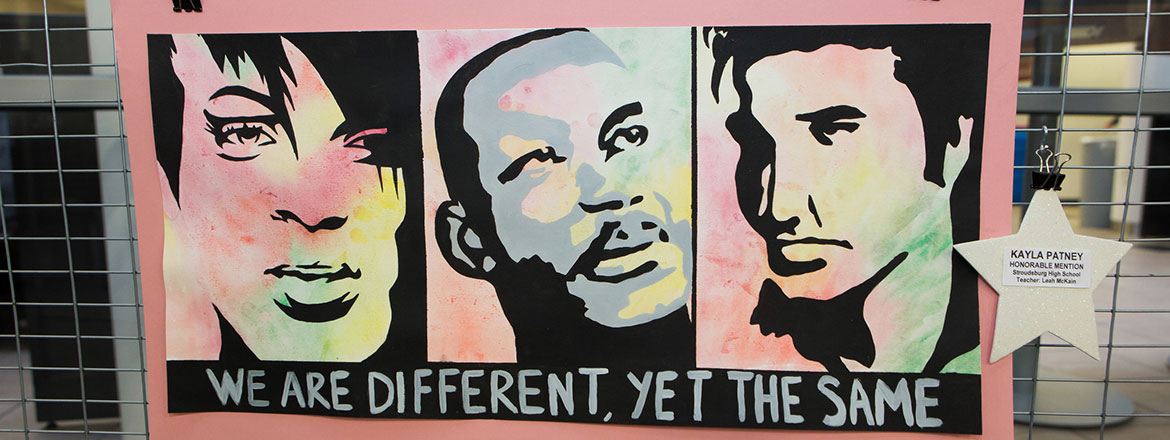
Native American and Indigenous Students
Native American culture and history are rooted within East Stroudsburg University.
To honor the rich legacy of indigenous peoples, ESU named residence halls after Native tribes: Lenape, Minsi, and Shawnee.
Memorandum of Understanding with the Delaware Tribe of Indians of Oklahoma
In September 2018, ESU and the Delaware Tribe of Indians of Oklahoma entered into a partnership hoping to provide education surrounding Native American culture, and eventually produce a scholarship for Native American students to be able to return to spaces their tribe formerly inhabited.
As part of the MOU, The Delaware Tribe of Oklahoma moved their Eastern Tribal Historic Preservation Office, Eastern Office to ESU, and the office is now located on the fourth floor of Stroud Hall. This partnership has enabled collaboration between the tribe and ESU students, faculty, and staff. The MOU creates opportunities for archeologist's, historians, and others to strengthen interdisciplinary programs and develop new ones. Other opportunities include undergraduate research, distance learning, and grant funding.
Land Acknowledgment Statement
A land acknowledgment statement recognizes and pays homage to the original inhabitants (Indigenous people) of the land. These statements are often read at the beginning of public gatherings and programs.
ESU’s Land Acknowledgment Statement
Land Acknowledgment Call to Action
ESU recognizes the systemic inequities that stem directly from colonization, displacement, and genocide experienced by Indigenous communities throughout history. We commit ourselves to acknowledging this long history of injustice. We commit ourselves to working to better educate and tell these truths. We commit ourselves to preserving the Indigenous land we inhabit.
Annual ESU Events
East Stroudsburg University celebrates Native American culture and history throughout the year. In particular, Tammany Day, the Pow Wow, and Native American Heritage Month provide an opportunity to recognize the significant contributions of Native Americans to the establishment, growth, and development of the United States.
Tammany Day on May 1 is a National Day of Recognition
In 2003, the United States Congress ratified May 1 as a day of recognition to honor Tammany (Tamanend or Tammamend), the “affable” (c. 1628–c. 1698). Tammany was a chief of one of the Lenape clans in the Delaware Valley at the time Philadelphia was established. He is known as a lover of peace, proponent of friendship, fairness, justice, and equality. Tammany participated in a meeting between the leaders of the Lenape and the leaders of the Pennsylvania colony reputedly held under a large elm tree at Shackamaxon (Fishtown, Philadelphia) in the early 1680s. His above-named attributes placed him in a pivotal role to help establish peaceful relations among the Native American tribes and the English settlers led by William Penn.
Pow Wow
Pow Wow, an Algonquian word, is a Native American gathering that brings the community together to dance, sing, and celebrate. Algonquian is the language family to which Lenape belongs. It is a time of healing, feasting, and renewing or creating friendships.
Today's Pow Wow often includes both social and competitive dancing that can last for several days. Many of the dances hold significant cultural and sacred meaning. This event allows tribal members to express their culture, reaffirm their heritage, and honor the resilience of both their ancestors and their enduring communities.
East Stroudsburg University is currently planning its first on-campus pow wow.
November is Native American Heritage Month
In 1990, President George H.W. Bush declared November as Native American Heritage Month. This month-long celebration provides an opportunity for us to learn about Native American/Indigenous cultures, traditions, histories, and contributions. It also affords us an opportunity to learn about colonization, displacement, and genocide experienced by Native American/Indigenous communities throughout history.
While a violent legacy of global colonization has imposed devastating conditions on Native American/Indigenous communities worldwide, many continue to fight for justice and resist oppressive circumstances. To educate the public, every November, Native American/Indigenous activists, poets, story tellers, culture bearers, and tribal leaders organize countless events showcasing their rich and diverse cultures and histories.
Cultural Resources
Connecting to community is important! Your community gives you a sense of belonging and makes you feel part of something greater than yourself. You can find mentors and role models. You can learn more about your culture. You can also discover opportunities to volunteer and give back.
Contact Us
Contact Information
- Campus Address
- Reibman Administration Building
- Phone:
- (570) 422-3463
- Fax:
- (570) 422-3410 (Fax)
- Title of Department Leader
- Vice President, Campus Life & Inclusive Excellence
- Name
- Dr. Santiago Solis
- E:
- ssolis@esu.edu




